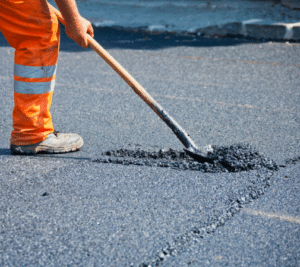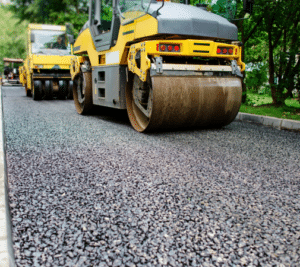Road safety is a paramount concern for transportation authorities and the general public. With millions of vehicles traversing roads every day, it becomes crucial to implement effective measures to enhance skid resistance and minimize accidents. One such technique gaining prominence in recent years is microsurfacing. This innovative road maintenance process involves the application of a thin layer of asphalt emulsion mixed with fine aggregates. In this blog, we will explore the benefits of micro-surfacing, its impact on skid resistance, and how it contributes to overall road safety.
Understanding Microsurfacing
Microsurfacing is a preventive maintenance technique used to rejuvenate and extend the lifespan of aging road surfaces. It is a cost-effective alternative to traditional methods such as resurfacing or reconstruction. The micro-surfacing mixture combines a precise blend of polymer-modified asphalt emulsion, fine aggregates, mineral fillers, and water. The slurry is applied in a controlled manner using specialized equipment, ensuring uniform coverage and thickness.
Benefits Of Microsurfacing
Cost Savings
The cost-effectiveness of micro-surfacing makes it an attractive option for road maintenance projects. By extending the life of existing roads, microsurfacing reduces the need for costly reconstructions and repairs over time. The minimal disruption during application also cuts down labor costs associated with lane closures and traffic control. Additionally, microsurfacing requires fewer resources than traditional paving methods as it uses less material.
Skid Resistance
The newly-applied micro-surfacing layer creates a smoother surface, which improves tire traction and increases skid resistance. This improved friction reduces the likelihood of slipping and sliding on wet roads, thus improving road safety. As an added bonus, the new surface also eliminates any ruts or potholes in the existing pavement.
Durability and Longevity
Microsurfacing provides a durable, long-lasting solution for maintaining roads. The polymer-modified asphalt emulsion used in the mixture adds strength and flexibility to the surface, making it more resistant to wear and tear caused by traffic. The added durability extends the life of the road, reducing the frequency of significant repairs or reconstructions.
Additionally, micro-surfacing protects the underlying pavement from oxidation, ultraviolet radiation, and other environmental factors, thereby preventing premature deterioration. The sealed surface prevents moisture penetration, which can cause cracks and potholes, ensuring the road remains intact and safe for an extended period.
Environmentally Friendly
The environmentally friendly nature of microsurfacing makes it an ideal choice for sustainable road maintenance. The application process requires no solvents or volatile organic compounds, which reduces air pollution and helps to preserve the surrounding ecosystem. Additionally, the reduced amount of material used in microsurfacing further cuts down on its environmental impact.
Quick Application and Minimal Disruption
Microsurfacing offers the advantage of minimal disruption during application. Unlike traditional road construction methods that require lengthy closures, micro-surfacing can often be applied lane by lane, allowing traffic to flow with minimal interruption. The rapid curing time of microsurfacing, usually within a few hours, enables a swift return to normal traffic conditions.
The expedited application process minimizes inconveniences to road users and reduces traffic congestion and associated safety risks. By reducing the time spent on road maintenance activities, microsurfacing also improves worker safety.
How Often Should Microsurfacing Be Done?
Microsurfacing is a cost-effective and efficient way to extend the life of asphalt pavements by providing a thin protective layer that seals and smooths out the surface. The frequency of micro-surfacing depends on various factors such as traffic volume, climate, pavement condition, and maintenance history. Generally, micro-surfacing should be done every 5 to 7 years to maintain the pavement’s integrity and prevent further deterioration. However, if the pavement is heavily trafficked or exposed to harsh weather conditions, microsurfacing may need to be done more frequently. Proper maintenance and regular inspections can help determine when microsurfacing is necessary to ensure the pavement’s longevity and safety.
How Much Does Microsurfacing Cost?
The cost of microsurfacing depends on various factors such as the type and condition of the pavement, traffic volume, size of the project, required materials, labor costs, and other associated expenses. On average, micro-surfacing can cost anywhere from $2 to $5 per square foot. However, it is important to consider that while micro surfacing is a less expensive option than milling and repaving, it is still a significant investment. It is also important to factor in the long-term benefits of micro-surfacing in terms of extended pavement life, reduced maintenance costs, improved safety, and environmental friendliness.
Wrapping Up
Microsurfacing is a game-changer in the world of pavement maintenance and repair. With its cost-effective and eco-friendly approach, it’s no wonder more and more cities are turning to this innovative solution. So the next time you see a freshly micro-surfaced road, take a moment to appreciate the technology and effort that went into making it smooth and durable.
Saguaro Asphalt provides expert micro-surfacing services. Their experienced team offers quick and efficient applications with minimal disruption, making them the perfect choice for your road maintenance project. Contact Saguaro Asphalt today to get started on your microsurfacing project and reap all the benefits of a smooth, skid-resistant surface that will last for years!



